The Range began as a single Plymouth store in 1989 and is now an established household name with more than two hundred outlets across the United Kingdom and Ireland. In late 2020 the business launched its own online marketplace. That decision has changed the shape of its e‑commerce operation: by mid‑2024 half of every pound spent on therange.co.uk was being taken by an external merchant rather than by The Range itself.The company describes the marketplace as a central growth driver and the figures support the claim. Its website attracts about two hundred million visits each year, it carries more than three hundred and forty thousand individual products across one thousand eight hundred categories and it already works with roughly eleven hundred approved sellers.
What is The Range Marketplace?
TheRange Marketplace is the online third-party selling platform of TheRange, a popular UK retail chain known for home, leisure, and garden products. Launched in late 2020, this marketplace allows approved external sellers (called “Range Plus Partners”) to list and sell their products on The Range’s website alongside the retailer’s own merchandise. The Range has joined other major UK marketplaces by creating an “Amazon-style” marketplace on its site, connecting sellers to The Range’s extensive customer base while The Range handles the e-commerce storefront and checkout.
As a seller on TheRange Marketplace, your products gain exposure to the company’s millions of shoppers. The Range boasts over 180 physical stores across the UK and Ireland and claims its website can introduce your products to over 43 million potential customers.The Range Marketplace is a relatively new but rapidly growing UK online marketplace channel. It offers sellers the chance to leverage The Range’s brand trust and traffic, similar to selling on Amazon or eBay, but with a more curated approach. It is not a second-hand platform or auction site it’s geared toward professional sellers offering new products, much like other top 10 online marketplaces in the UK (Amazon, eBay, OnBuy, etc.), but within The Range’s well-known retail ecosystem. This guide will explore why and how to sell on The Range Marketplace and how PlusRanger software can streamline the process for you and boost your sales.
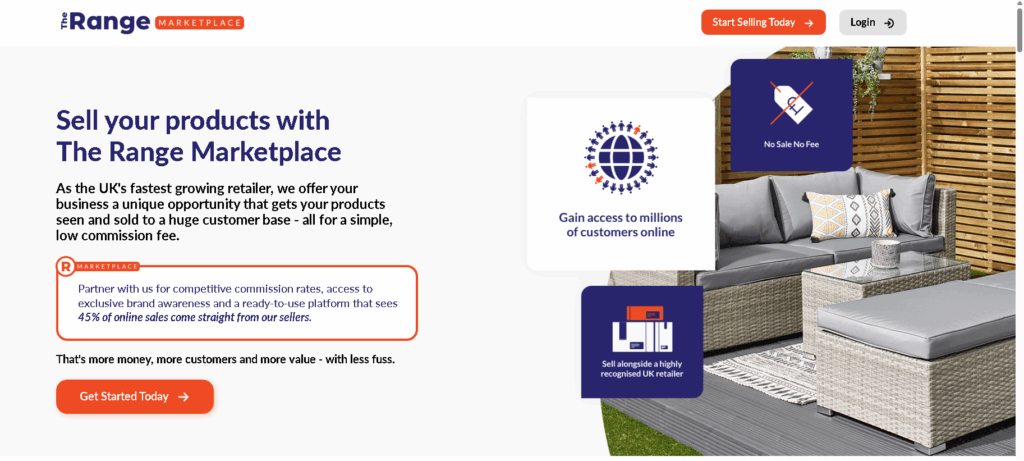
No Sale Means No fee
The marketplace operates on a single variable fee rather than on a fixed subscription. Commission sits between eleven and fifteen per cent depending on category. There are no listing charges, no monthly subscriptions fees and no penalty if nothing sells. For larger partners there is an optional cost price arrangement: the seller invoices The Range at an agreed cost and the retailer sets the retail price, taking the difference as its margin.
In either case, there are no listing fees, n monthly subscription fees, and a “no sale, no fee” approach, meaning you only pay when you actually sell something.
Merchants gain access to a large, growing but still relatively uncrowded pool of shoppers. The Range does not develop look‑alike private label lines based on marketplace data, removing a frequent complaint levelled at international platforms. Account managers actively invite selected products into email newsletters, home‑page hero spaces and social posts, giving sellers regular bursts of free visibility that would otherwise require advertising spend.
The platform has no in house fulfilment offer similar to FBA, so the merchant’s own warehouse or logistics partner must be ready to meet customer expectations on speed, packaging quality and returns handling. Reporting tools continue to evolve and, although adequate for day to day operations, tools like PlusRanger offer more granular sales data . Category gating remains in force, so expansion into new product lines always involves an extra approval step.
Why Sell on The Range Marketplace ?
Selling on The Range Marketplace comes with several compelling advantages that make it an attractive new channel for UK sellers. Here’s why you should consider The Range as part of your multi-channel strategy:
The Range is a familiar high-street name with millions of loyal shoppers. By listing on its marketplace, you tap into an audience of up to 45 million potential customers who already trust The Range’s brand, Gaining visibility on such a well-known retail site can boost your reach and lend credibility to your products. This positive brand association means your goods appear alongside established brands. Compared to other uk marketplace alternatives like Amazon or eBay, The Range Marketplace currently has far fewer sellers and products, which means less competition for attention. Critically, The Range grants each marketplace seller exclusive rights to be the only vendor for a given product on the platform. In other words, no other third-party seller can offer the identical SKU on The Range’s site. This eliminates the fierce price wars you see on Amazon where dozens of sellers compete for the same listing. You won’t be undercut by other sellers on your own product listing a unique benefit that allows you to maintain healthier margins and stable pricing.
No Conflict of Interest
Unlike Amazon, The Range Marketplace itself does not use marketplace sales data to launch competing private-label versions of your products. Amazon sellers often worry about Amazon’s own brands or it becoming a direct competitor; by contrast The Range’s role is to host your products, not copy them. The Range does sell its own branded merchandise in some categories, but as a partner you typically list products that complement or expand their catalogue rather than directly compete with The Range’s in-house stock. This means no direct conflict with the platform owner a relief for brands wary of the Amazon scenario.
What Are TheRange Marketplace Fees
The Range operates on a straightforward commission-based fee structure no sale, no fee. There are no monthly seller subscriptions or listing insertion fees at all.
You only pay a commission after an item sells, plus a small payment processing fee (and optionally advertising costs if you opt in). Commission rates are a flat percentage based on product category (typically ranging ~11–15% for most categories) which is simple to factor into pricing. This transparent fee system is often easier to navigate than Amazon’s myriad fees (subscription, referral fee, FBA fees, etc.) or eBay’s listing fees and store tiers.
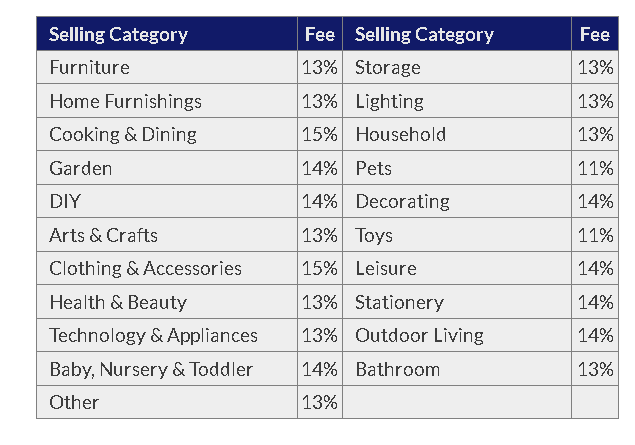
For example, if you sell a £100 furniture item, The Range would deduct 13% (£13) as commission for that category and a payment processing fee (around 2% or a few pence) and that’s it. No other hidden fees. In contrast, selling the same item on Amazon UK would require a £25+VAT monthly pro account fee (if you’re a pro seller) and a ~15% referral fee, and possibly fulfilment fees if using FBA. The Range’s simpler fee model lowers your cost of entry.

The Range is known for home, garden, leisure and DIY products categories that see steady demand. If you operate in these niches, The Range’s customer base is highly relevant. That said, the marketplace covers a wide array of departments beyond just home goods, including furniture, electronics, lighting, appliances, toys, crafts, pet supplies, clothing, health & beauty and more. This broad coverage means many types of sellers can find a market, while still benefiting from The Range’s core reputation in home and garden. The marketplace was already significant only months after launch about 30% of products sold on The Range’s website in summer 2020 were from third-party suppliers indicating robust customer adoption.
Expanding to The Range Marketplace helps diversify your sales channels beyond Amazon, eBay, or your own site. It’s wise not to put all eggs in one basket each marketplace has a unique audience. The Range’s shoppers might not be as active on eBay or might trust buying certain products more from The Range’s site. Adding this channel can boost your overall sales and reduce reliance on any single platform. Notably, another emerging marketplace, OnBuy, also offers an Amazon alternative for UK sellers. However, OnBuy, while growing, doesn’t have an established retail brand behind it. The Range combines the online marketplace model with the power of an existing retail brand and physical presence. Sellers have reported that competition on The Range is lighter than on Amazon or eBay, but the conversion rates can be strong thanks to the brand trust factor.
The Range Marketplace is not a free-for-all open market; only vetted businesses sell, and items are generally new (not second-hand). This consistent, retail-like experience attracts customers who may avoid the uncertainty of eBay’s auctions or used item listings. For sellers, this means you’re operating in a professional environment where buyers expect new, quality products much like Amazon’s marketplace. It helps protect your brand value and pricing, without being undercut by second-hand offers.
Customer Can Purchase Your Products Instore
One interesting perk of The Range Marketplace is that your products aren’t limited to just web shoppers. The Range has integrated its marketplace with its omnichannel sales channels. Customers can order marketplace items online 24/7, via The Range’s mobile app, and even in-store digital screens.
For example, if a customer in a physical The Range store wants an item that the store doesn’t stock but is available via a marketplace partner, the store can facilitate that order. This is extra exposure that pure e-commerce sites can’t offer. Essentially, your listings can be reached by shoppers who walk into any of The Range’s 200+ stores (they can place an order at the store for home delivery) something not possible with marketplaces like Amazon or OnBuy which are online-only. This integration of offline and online channels can net you additional sales from The Range’s in-store footfall, especially during peak seasons couple it with Plusranger you will be able to understand where majority of your sales are coming.
The Range Marketplace gives you the best of both worlds: access to a massive, loyal UK customer base with relatively low competition and friction, and a platform that’s seller-friendly in terms of fees and policies. It’s a chance to get in on a growing marketplace early, before it becomes crowded. Many sellers are finding it a profitable supplement to Amazon or eBay. And with the right tools like PlusRanger you can manage this new channel with ease alongside your other sales channels. In the next sections, we’ll cover how to get started and best practices for succeeding on The Range.
How to Get Approved for The Range Marketplace
You must be a registered business in the UK to sell on The Range
This means having a UK company registration (Ltd, PLC, etc.) or at minimum a UK-registered sole proprietorship. If your business is based outside the UK, you’ll need to have a UK VAT registration number and likely a UK entity or address to qualify. Additionally, you need a UK bank account for receiving payout.The Range does not currently support individual casual sellers it’s oriented toward established businesses. Make sure you can also ship orders within the UK and handle returns (more on that later).
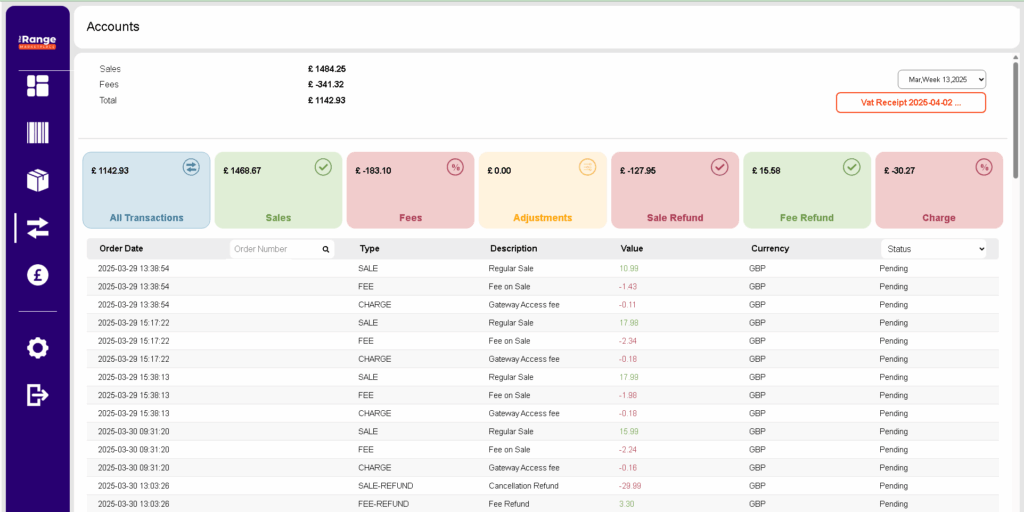
During sign-up you’ll provide details about your company and products. Be ready with your company registration number, VAT number, bank details, contact info, and an overview of the product categories you sell. The Range may also ask for supporting documents to verify your business (proof of address, ID for the account owner, etc.). Having a catalogue or website of your products can be helpful to demonstrate what you plan to sell.
Visit The Range Marketplace’s “Sell With Us” page and complete the online sign-up form. The form will ask for your business info and also how you plan to integrate (you can indicate if you’ll use an API, a tool like PlusRanger, or even spreadsheets). You’ll also specify the number of products you intend to list (ranges are given, e.g. <100, 100-500, etc.). This helps The Range plan onboarding support. When filling out the form, be honest and thorough a complete application speeds up approval.
The Range will evaluate your application, checking that your business meets the criteria and that your product range fits their marketplace. They might reach out with questions or requests for documents to verify identity, VAT status, or product information. Response times are usually quick the marketplace team aims to onboard new sellers efficiently.

Once your account is created, you may still need to get approval for specific categories before you can list products. The Range requires sellers to apply for the categories they wish to sell in via the Partner Central portal. For example, if you indicated you sell home furnishings and garden items, those categories might be enabled by default. If you want to add a new category (say, start selling electronics later), you would use the “Add Categories” function in your account, search the relevant subcategory and click apply. The Range reviews category requests (likely to ensure sellers list in appropriate departments) and will approve them, showing the commission rate for each category as you apply. This process ensures a level of oversight on what types of products enter the marketplace.
Sell On The Range Marketplace
After approval, The Range will guide you through final onboarding: setting up your Partner Central account (login credentials), and prompting you to configure important settings. Before you start listing items, you must input your shipping (delivery) options and set up your returns information, and add your bank payout details .Essentially, you prepare your seller account so that orders can be properly shipped and you can get paid. Once these are configured and categories approved, you are ready to list products and go live on the marketplace.
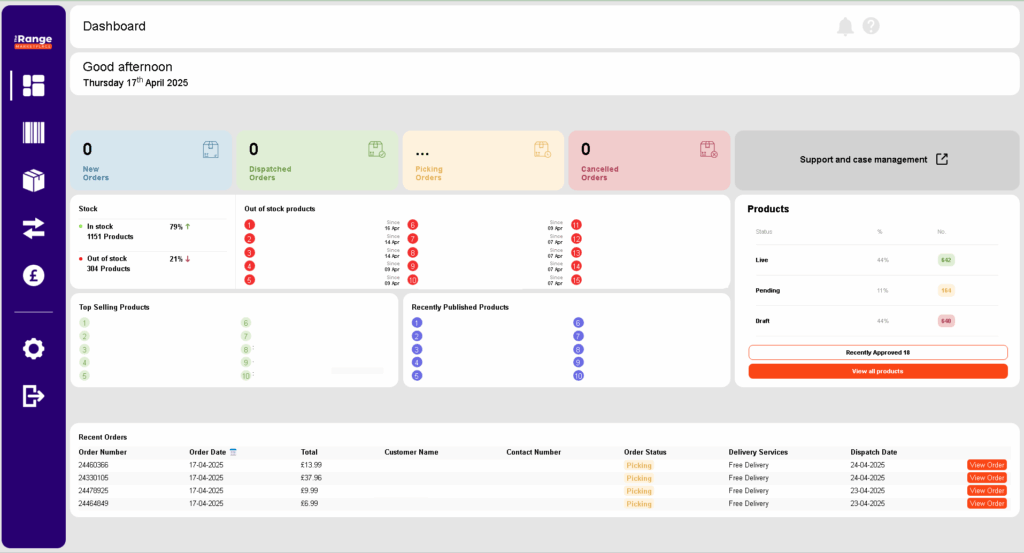
The initial application is handled directly with The Range, but once you’re approved, PlusRanger can greatly assist in the onboarding process and even provide consultancy . PlusRanger’s team is familiar with The Range’s requirements and can help ensure your product data (titles, descriptions, images) meet The Range’s standards for quality. He software can also integrate your product feed quickly via API. In short, get your account approved first, then let PlusRanger take it from there to bulk-upload listings and sync your operations as you launch on this new channel.
What Are the Selling Fees for The Range Marketplace ?
The Range charges a commission on each sale, calculated as a percentage of the total order value and the commission percentage depends on the product category. Most categories fall in the 11% to 15% range. For example, the commission is 13% for furniture, home furnishings, lighting, etc., 14% for garden, 15% for cooking & dining or clothing, 11% for toys and pet products, etc. A few categories like tech gadgets have lower rates.More recently they added a payment processing fee precentage of 1% to cover payment processing (credit card, PayPal, etc.) For planning purposes, assume a minor percentage will be deducted to cover the transaction processing by The Range’s payment provider. This fee is relatively small but ensure to account for it in your margin calculation.
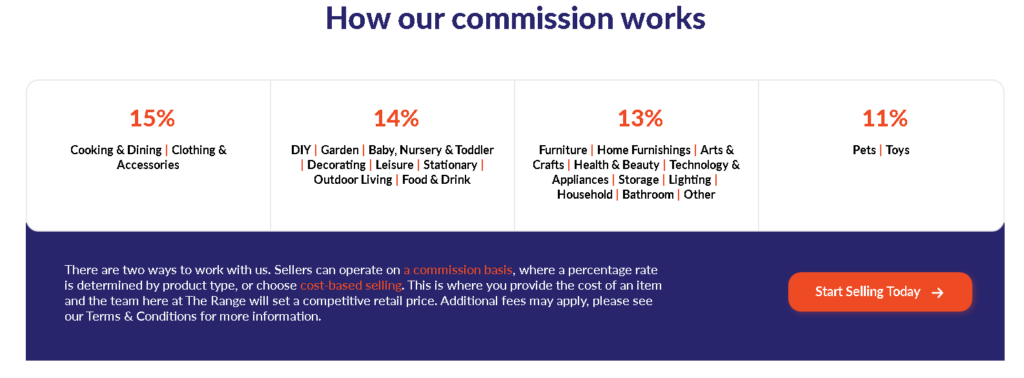
There are no monthly storage fees or subscription packages for The Range Marketplace. Unlike Amazon (which charges £25+ VAT per month for a Pro account) or OnBuy (which has membership plans for lower fees), The Range does not charge you just for the privilege of being a seller. There are also no listing insertion fees for creating product listings (eBay, for instance, might charge per listing after a certain number each month). You can list unlimited products without incurring upfront fees. This “no sale, no fee” model means you can try the marketplace without fixed costs eating into your budget a simpler and lower-risk fee structure.
The above fees describe the standard commission-based partnership, where you set a retail price and The Range takes a commission cut. The Range also has an alternative model called Cost-Based Seller for certain suppliers. In that model, you as a supplier provide The Range with a cost price for your product (inclusive of shipping cost and VAT), and The Range itself sets the retail price on their site. When the item sells, you receive the fixed cost amount you stipulated, and any markup above that (minus taxes) is The Range’s revenue (effectively their “fee”).
This arrangement is more like a wholesale/consignment relationship and may be offered to brands who prefer The Range handle pricing or when The Range wants to avoid price competition. If you go the cost-based route, you won’t see a per-sale commission percentage; instead, you get your fixed amount per sale. The Range might choose to discount or adjust the retail price over time, but your payout remains the agreed cost. Most smaller sellers will use the commission model where you control pricing. It’s good to know the cost-based option exists (some larger vendors use it to move volume without micromanaging prices). For this guide, we assume the typical commission model unless noted.
The Range’s terms note that if an order is refunded or cancelled, the commission (platform fee) may not be returned to the seller in some cases. In practice, if a customer places an order and then returns the item, The Range can retain the commission as a “platform fee” to cover transaction costs. (This is somewhat stricter than Amazon, which refunds part of the fee minus a small refund fee.) However, The Range’s policy also involves charging customers return fees for change-of-mind returns, which can offset the loss. Just be aware that fees on a sale might stick even if the sale reverses, so customer service and minimizing returns is important.
The Range will provide you a statement of fees for each payout cycle (so you can see commissions taken). With PlusRanger’s profit and loss dashboard for TheRange markeplace, you can automatically reconcile these fees against orders. PlusRanger’s dashboard lets you verify each payout and see profit after The Range’s fees per item sold, ensuring you have full visibility into your costs and margins for selling on The Range.
What Can You Sell on The Range?
The Range UK Marketplace supports a broad catalogue of product categories essentially any item that aligns with The Range’s existing departments or logically extends their assortment. When they launched, The Range focused on home, garden, and leisure categories, but they have since expanded into many other areas. Here’s an overview of what you can (and can’t) sell on The Range:
Allowed Categories: The main categories include:
-
Home & Furniture: Indoor and outdoor furniture, home furnishings (decor, textiles, lighting, wall art), kitchenware, diningware, home organization and storage solutions. The Range is known for home goods, so these categories perform well.
-
Garden & DIY: Gardening equipment, plants and accessories, garden furniture, outdoor decor, tools, hardware, DIY materials, and decorating supplies (paint, wallpaper).
-
Electronics & Appliances: “Technology & Appliances” category covers consumer electronics (small gadgets, accessories, maybe select larger electronics) and home appliances. Commission around 13% for which is competitive. The Range sells things like TVs and kitchen appliances themselves, but partners can offer a wider selection or complementary gadgets.
-
Leisure, Toys & Crafts: This includes toys, games, arts and crafts supplies, hobby items, sports and outdoor leisure products. Toy category commission is low (~11%) encouraging toy sellers. Arts/Crafts ~13%. Leisure (camping, fitness, etc.) ~14%.
-
Pets & Pet Care: Pet food, pet accessories, habitats (e.g. aquariums, bird cages), and other pet supplies are allowed. Pet category commission is about 11%. The Range has an existing pet section, and marketplace can expand it.
-
Clothing & Accessories: The Range signaled interest in expanding into clothing, shoes, and accessories.They now allow fashion items likely focusing on casualwear, outdoor apparel, maybe home textiles (robes, slippers) etc.
-
Health & Beauty: Cosmetics, skincare, health devices, etc., are permitted.This category might require extra vetting (especially for branded perfumes or cosmetics to avoid counterfeits). Ensure you have authentic products and perhaps brand authorization if applicable.
-
Baby & Nursery: Baby products, nursery furniture, toys for toddlers, etc.
-
Stationery & Office, and Miscellaneous: Stationery, office supplies, books or craft books could be listed.
In short, most physical, non-perishable consumer goods can be sold on The Range. The marketplace’s mission was to bring customers a wider selection “across more departments than ever before” by teaming up with partners. The Range, being a family-friendly retailer, will have restrictions similar to other marketplaces. While their seller guide doesn’t list every prohibited item publicly, expect that you cannot sell firearms or weapons, adult-only products, illegal items, prescription drugs, or anything that would violate UK law or The Range’s brand image. Also, no counterfeit or unlicensed products are allowed you must have legit inventory. Food and grocery items are generally not part of The Range Marketplace because The Range’s grocery offerings are through an Iceland partnership in stores (and not sold online). So, stick to non-perishable consumer goods.The Range prohibits used or second-hand goods on the marketplace. All items should be new condition. This is implied by their emphasis on quality and that marketplace orders are “contract of sale between you and the customer” for new goods.
How to Create Listings on The Range
Once your seller account is approved and set up, the next step is to get your products listed for sale. The Range Marketplace provides multiple methods to create and manage listings, catering to both newcomers with a few products and high-volume sellers with thousands of SKUs. Here’s how to create product listings on The Range Marketplace:
1. Manual Listing via Partner Portal: If you have a relatively small catalog, you can add products one by one through The Range’s online portal (Partner Central). The interface lets you input product details similar to other marketplaces:
-
Product Title, Description, and Specifications: Provide a clear title and detailed description. The Range likely has guidelines for content (e.g. no all-caps, include key features, etc.) to ensure professionalism. Include relevant keywords a customer would search for. Since The Range is a general marketplace, descriptive titles help (but keep them concise and clean).
-
Images: You’ll upload product images. Use high-quality images with plain backgrounds if possible. The Range’s customers expect retail-quality images (just like items sold by The Range itself). Ensure you have at least one good image; multiple images (showing different angles or uses) are ideal.
-
Category and Attributes: During listing, you will choose the category (and subcategory) that the product falls under limited to those you have approval for. Then fill in any required attributes (e.g. brand, dimensions, colour, material, etc. depending on category). Providing complete and accurate attributes will help your item show up in filters on the site.
-
Price and Stock: Set your selling price (VAT-inclusive) and input stock quantity. You also choose the shipping methods the product is eligible for (based on the delivery services you set up). For example, if you offer Standard 3-5 day delivery and an Express option, you’d ensure the product is eligible for those. Also set the product’s weight and dimensions, as this can affect shipping options and return fees. (The Range uses weight to determine return postage fees, so it’s important to list accurate weights)
-
SKU/Identifiers: You’ll enter a SKU or reference for your own tracking. If the product has a barcode (EAN/UPC), you may provide it, though The Range may not require this if the product is unique to you.
Manual adding is “straightforward, even for beginners” according to The Rang It’s a good way to start if you just have a few items to test the waters. After inputting, you submit the listing and it should go live on The Range’s site (possibly after a quick review or overnight update).
2. Bulk Upload via Spreadsheet/CSV: For larger catalogues, The Range allows bulk product uploads using CSV templates. You can download category-specific CSV templates from Partner Central. These files have columns for all the product fields (name, description, price, stock, etc.). You populate the spreadsheet with your product data (one row per SKU) and then upload it. This uploads in bulk.
3. Integration via API or Third-Party Tools: The Range has a full API for sellers, meaning you can integrate through third-party e-commerce management software or your own system. In fact, during sign-up they ask for your preferred integration method (options like PlusRanger, API, or Spreadsheet ). If you already use a multi-channel platform (like PlusRanger), check if they have a direct integration for The Range .With PlusRanger not only you get software but our in house marketplace consultant can help you with any questions or problems you have.
Our specialised tool is PlusRanger, which is built specifically for The Range Marketplace integration. With Plus Ranger, you can create and update listings in bulk with ease it essentially handles not just listings but dispatching, inventory management and customer management. Instead of manually entering data or wrestling with CSVs, PlusRanger can import your product feed (from your online store or other marketplaces) and publish listings on The Range Marketplace in an automated way. It ensures all required fields are filled and even confirms when your listing is live. PlusRanger also supports variant listings, price updates, and content edits in a centralized dashboard, so you can manage your The Range product catalogue alongside your other channels. If you’re serious about listing dozens or hundreds of products, an integration tool like this saves considerable time and reduces human error.
4. Listing Quality and Approval:
When you create listings, The Range might do a light review, especially for new sellers. Ensure your listings meet their standards:
-
Avoid prohibited content (no offensive language, etc.).
-
Make sure the product is categorized correctly.
-
Provide truthful, non-misleading information. The Range wants to maintain a good customer experience, so they may remove or ask you to edit listings that don’t comply with guidelines. In practice, if you follow the template and input everything properly, your listings should go through. If an item doesn’t appear on the site after uploading, check if it’s pending approval or if there were errors (the portal might flag issues like missing data).
5. Inventory Sync: After listings are created, remember to keep your stock quantities updated to avoid overselling. The Range requires regularly updated stock data. If you manually manage, you’ll need to adjust inventory in the portal when you sell out or restock. With PlusRanger, inventory sync is automatic it can update The Range with your latest stock levels in near real-time (especially useful if you sell the same SKU elsewhere). This prevents customers ordering an item that just sold out on another marketplace. Keeping inventory accurate also protects your seller performance (cancellations due to out-of-stock can harm your metrics).
Creating listings on The Range you have flexible options: manually via the portal for a handful of items, CSV uploads for batch entry, or API integration for automation. For new sellers, it might be wise to try a couple listings manually to learn the system, then move to bulk methods. Make sure to double-check how your product page looks on the live site (ensure images look good, text isn’t cut off, etc.). And leverage tools like PlusRanger for scaling up it can handle bulk listing uploads and even has features like tracking profit and loss.
How to Dispatch Your Orders On TheRange Marketplace
Dispatching your orders is crucial to maintaining strong seller performance and customer satisfaction on The Range Marketplace. After customers place orders, you need a reliable process to ensure timely and accurate dispatch.Orders placed on The Range Marketplace appear immediately in your seller dashboard within the Partner Central portal. You can view, manage, and update orders directly through the marketplace interface. However, managing multiple orders individually can become cumbersome as your sales grow and you will need to use a third party software like PlusRanger which allows bulk dispatching.
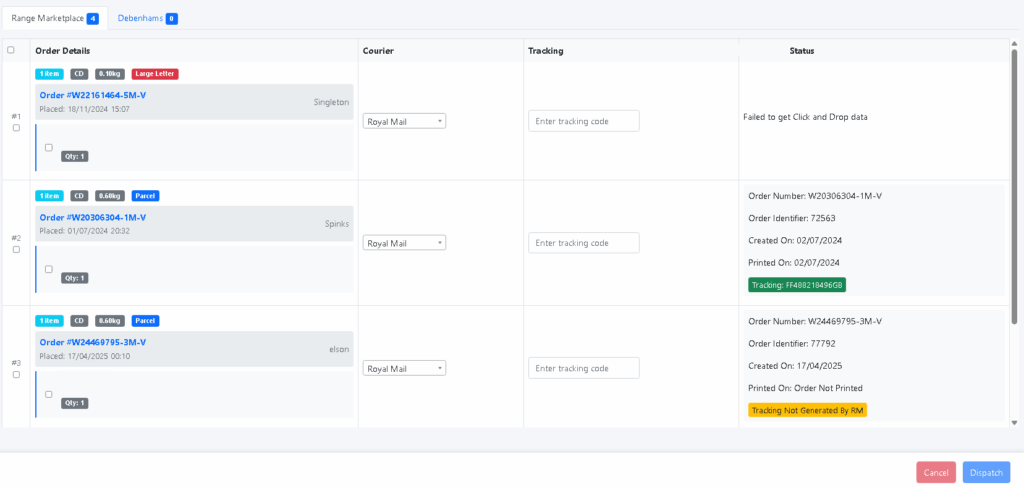
To simplify and speed up your order dispatch process, consider using an integration platform like PlusRanger. PlusRanger seamlessly connects to The Range Marketplace, automatically importing your orders into popular shipping solutions such as:
- Royal Mail Click & Drop
- EVRI
- Parcel2Go
This automation significantly reduces manual data entry and errors, freeing up time to focus on other areas of your business.A key advantage of PlusRanger is its ability to bulk dispatch orders efficiently. Instead of dispatching orders individually, you can process numerous orders simultaneously, saving considerable time, particularly during peak seasons and promotional events.
With PlusRanger, you can:
- Import orders directly into your chosen courier platforms.
- Automatically update order statuses on The Range Marketplace.
- Instantly upload tracking details back into the marketplace, improving transparency for your customers.
How to Set Prices on The Range
Pricing your products correctly on The Range Marketplace is key to success. You want to stay competitive to attract The Range’s shoppers, yet ensure you cover fees and make a profit.The Range takes a category-based commission and payment fee, factor those into your pricing. For example, if your item’s target base price is £10 and you have a 13% commission, list at a price that ensures you still net around £10 after fees which might mean a listing price of ~£11.50 in that case. Always price VAT-inclusive (if you’re VAT registered) as consumer prices on the site include VAT. This means if you want £10 net and you’re VAT registered, you might actually list at ~£12 (£10 net + 20% VAT = £12, then plus commission on top of that) and also include Free Delivery.With no monthly fees, you don’t have to spread fixed costs into price, but do include a cushion for the commission. Use our UK Marketplace Calculator tool can assist it can show you profit margins after The Range’s fees and even PlusRanger auto-reprice tool to maintain margins or hit certain price points.
By setting competitive yet profitable prices, you’ll attract The Range’s shoppers and sustain your business growth. The lack of direct marketplace competition means pricing on The Range is more about aligning with consumer expectations and covering your costs, rather than undercutting rivals. Focus on value: if you have great product listings (good descriptions, images) and your price is fair, you should do well. Plus, as you participate in The Range’s holiday promotions and other events, you might temporarily adjust pricing for those campaigns, which we’ll delve into next.
How to Participate in The Range Holiday Offers
Just like any major retail platform, The Range runs promotions and special offers during key shopping seasons (think Black Friday, Christmas, Boxing Day, etc.). As a marketplace seller, you have opportunities to ride the wave of holiday traffic and boost sales through these events. Participating in The Range’s holiday offers and seasonal campaigns can significantly increase your visibility and its FREE as long as you offer meets the percentage discount.The Range Marketplace team will often announce upcoming promotional events or invite sellers to join special offers via email and they have a short window to get offers.
Even if you’re not officially in a Range-run campaign, you can still create your own holiday sale by adjusting your prices or offering bundles. For example, during November you might mark all your products 10% off for Black Friday/Cyber Monday week. Your discounted prices will make your listings more attractive during the high-traffic period. Shoppers on The Range’s site during holiday season will be looking for deals.
If you have lots of SKUs and want to put them all on sale, PlusRanger can facilitate bulk price updates. You can filter the products you want to discount and update their prices in one go, rather than editing each manually. During busy times, automation helps e.g., quickly marking 50 items 15% off for a Christmas sale, then reverting prices later. PlusRanger will sync those changes to The Range’s system so they reflect on the site. This saves you hours and lets you be agile with promotions.
The Range Marketplace comes with three decades of high street reputation with lots of benefits and a seller friendly fee model. For businesses whose catalogues sit naturally in the home, leisure or garden space, the platform offers an attractive combination of broad reach, lower cost and hands on promotional support. Early adopters have already seen their turnover increase and the current seller count shows there is still room for newcomers. If you are looking for growth without the overhead of a monthly shop fee, The Range deserves serious consideration as a alternative uk marketplace.
If you need advice or want to see a demo of PlusRanger contact us!
